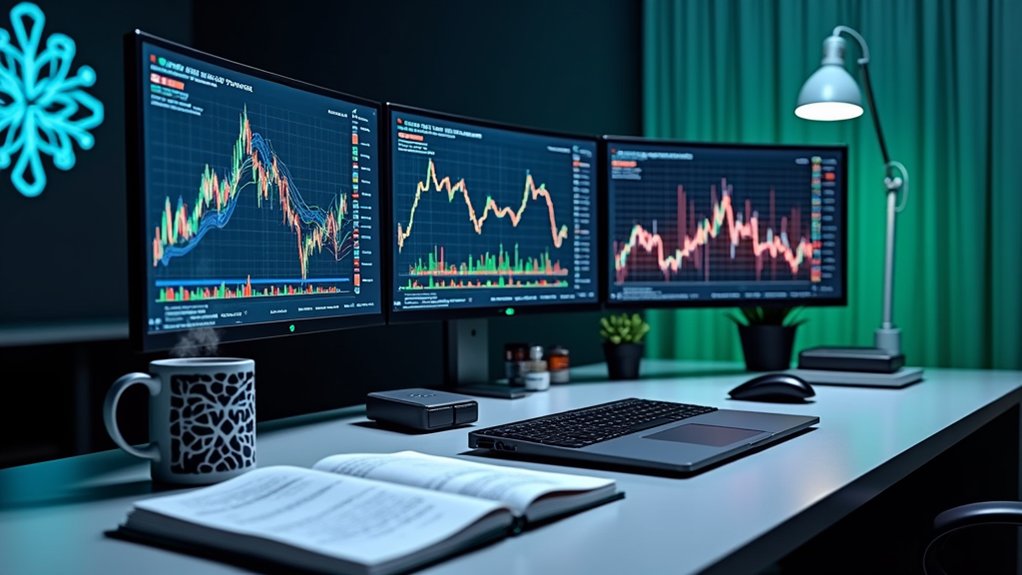Cryptocurrency futures trading enables investors to speculate on digital asset prices without owning the foundational cryptocurrency. These derivative contracts establish predetermined prices for future transactions, functioning in a zero-sum market where profits equal losses. Traders can employ directional strategies, utilize borrowed funds to control larger positions, and choose between standard expiration contracts or perpetual options. Successful participation requires selecting secure platforms with adequate liquidity, implementing disciplined risk management through stop-losses, and maintaining appropriate borrowed funds levels. Further examination reveals strategies for traversing this sophisticated financial ecosystem.

The cryptocurrency derivatives market, having developed considerably since its inception, now represents a sophisticated trading ecosystem where participants engage in futures contracts like powerful financial instruments for price exposure management.
The cryptocurrency derivatives market has matured into a complex ecosystem where futures contracts serve as essential tools for managing price exposure.
These agreements function by establishing fixed prices for asset exchanges or value transfer occurring at predetermined future dates, creating a financial structure where traders can implement strategies focused on hedging, speculation, or arbitrage opportunities. The zero-sum nature of this market means that for each profitable position, there exists an offsetting loss elsewhere in the system, with the ultimate profit or loss determination resting on the differential between contract prices and spot market values at settlement time.
Crypto futures contracts incorporate several essential components that define their operational framework, including specific expiration dates that signal contract termination points, standardized lot sizes that maintain consistency across trades, and leverage mechanisms that allow traders to control positions larger than their deposited capital would otherwise permit. Traders can take both long and short positions depending on their price direction predictions, enabling profit potential in both rising and falling market conditions.
Perpetual contracts, a popular innovation in the cryptocurrency space, circumvent traditional expiration constraints by implementing funding rate mechanisms that periodically transfer value between long and short position holders, effectively maintaining alignment with fundamental spot market prices.
Traders employ diverse strategies when maneuvering these markets, ranging from directional positions that capitalize on anticipated price movements to more sophisticated approaches like trend-following and mean reversion. Successful traders often utilize trading bots and signals to automate strategies and gain market insights. Technical analysis plays a crucial role in futures trading, with many traders relying on chart patterns to identify potential entry and exit points.
Critical to successful futures trading is the selection of appropriate trading platforms, with key considerations including robust security protocols, sufficient liquidity to minimize slippage, compatibility with intended strategies, transparent fee structures, and availability of analytical tools for informed decision-making.
Risk management represents the cornerstone of sustainable futures trading, requiring careful attention to margin requirements that protect positions from liquidation during adverse price movements.
Implementing strict stop-loss disciplines, employing judicious leverage, diversifying across multiple assets or timeframes, and maintaining an ongoing educational commitment all contribute to a thorough risk mitigation framework.
Since cryptocurrency markets continue evolving, traders must balance opportunistic approaches with disciplined risk protocols to maneuver this complex financial landscape effectively.
Frequently Asked Questions
What Are the Tax Implications of Crypto Futures Trading?
Crypto futures trading generates tax events through position closures or liquidations, with profits subject to capital gains taxation.
Under U.S. regulations, Section 1256 contracts on regulated exchanges benefit from the advantageous 60/40 rule, splitting gains into 60% long-term and 40% short-term capital gains, regardless of holding period.
Conversely, unregulated futures follow standard capital gains treatment, potentially resulting in higher taxation when held short-term, with gains reportable on Form 6781 for regulated contracts.
How Do Funding Rates Affect My Futures Positions?
Funding rates directly impact profitability by introducing periodic payments between long and short position holders, effectively serving in the capacity of a cost or revenue stream depending on position direction.
During positive rates, long positions incur fees that compound over time, potentially eroding profits or accelerating losses, particularly in margin trades. Conversely, negative rates benefit long traders while penalizing shorts.
These rates simultaneously function as market sentiment indicators, with persistently high rates often signaling overextended bullish positioning and increased liquidation risk.
Can I Automate My Futures Trading With Bots?
Automated futures trading is indeed achievable through specialized bot platforms, which execute transactions based on predefined parameters, technical indicators, and risk management rules.
Leading solutions like WunderTrading, 3Commas, and Binance's native tools offer customizable algorithms that operate continuously, eliminating emotional bias while enabling strategy optimization through backtesting.
These systems typically connect to exchanges via API keys, allowing traders to implement sophisticated approaches like Grid trading, DCA strategies, and signal-based execution across various market conditions.
What Happens to Futures Contracts During Cryptocurrency Hard Forks?
Cryptocurrency hard forks create significant uncertainty for futures contracts, affecting settlement terms and asset specifications.
Exchanges typically designate one chain as the "official" principal asset, with contracts settling against the dominant post-fork chain. Market participants face heightened volatility, increased liquidation risks, and potential contract ambiguities regarding deliverables.
Pre-fork speculation often distorts pricing, while post-fork, exchanges may establish parallel markets for forked assets or implement contract amendments to address the bifurcation of the principal blockchain.
How Do Insurance Funds Protect Traders in Futures Markets?
Insurance funds in futures markets function like protective mechanisms that safeguard traders against counterparty defaults by collecting fees from all market participants.
These capital reserves absorb losses when liquidations occur at prices worse than bankruptcy levels, preventing socialized losses across solvent traders.
During extreme volatility, these funds mitigate cascading liquidations by covering negative balances, thereby maintaining market integrity and trader confidence in the exchange's risk management infrastructure.









